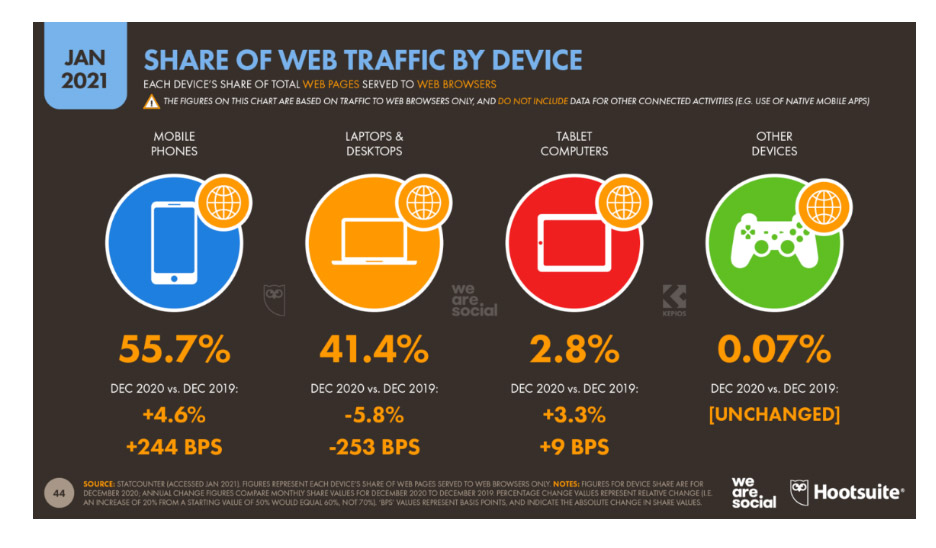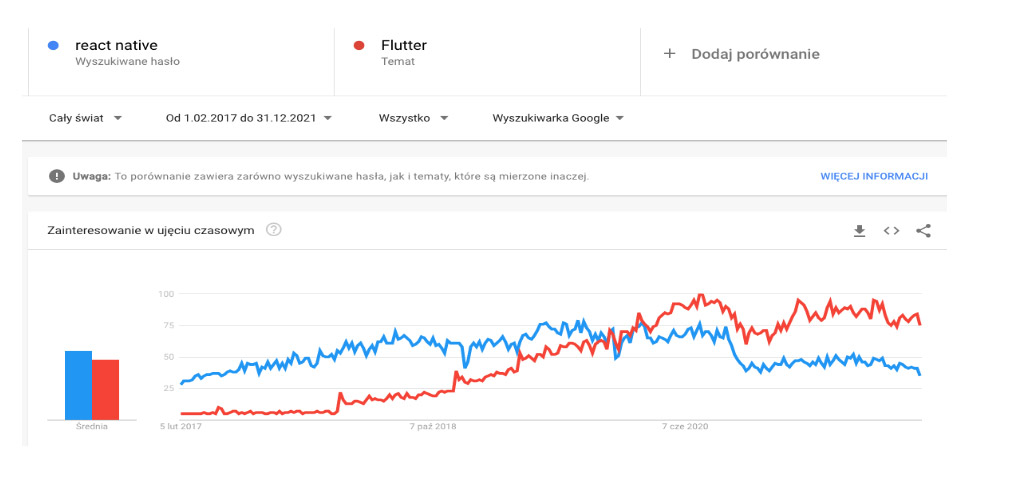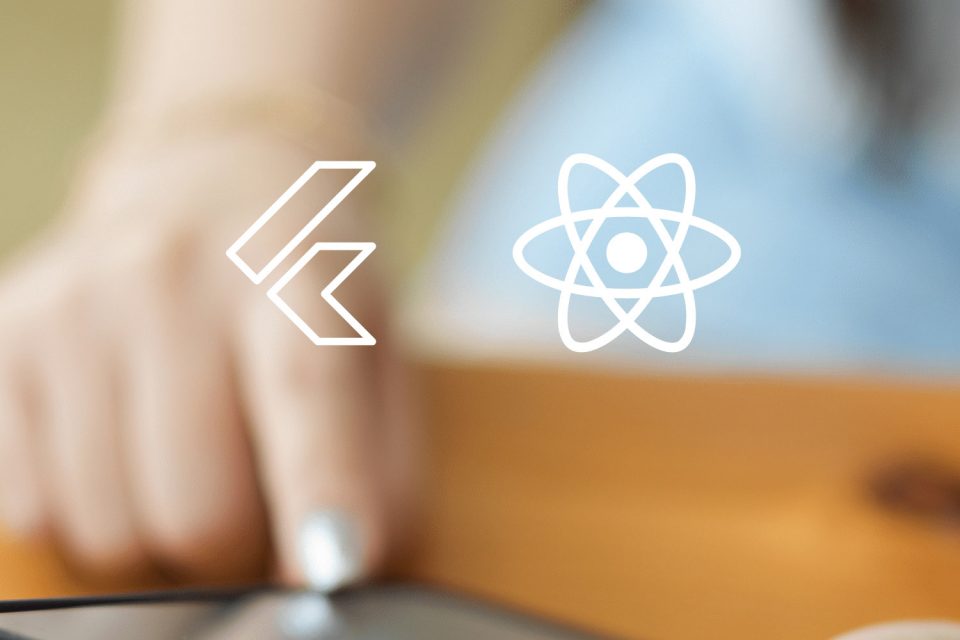A recent intensive and dynamic growth in e-commerce is mainly due to an increasing use of mobile devices to shop online. As a result, we speak of m-commerce nowadays. According to Pew Research Center around 81% of Americans own a smart phone, while 96% have access to one¹. In the first quarter of 2021 smartphones alone generated 55% of global web traffic².

source: https://datareportal.com/reports/digital-2021-global-overview-report
and continues to grow accounting for nearly three quarters of the global traffic. In light of these reports it should be more than evident that a mobile device friendly online store is a must have for any vendor. Retailers who implement m-commerce solutions act to facilitate brand-customer communication, product availability as well as ensure faster and smoother purchases.
Poland is no exception to m-commerce rising trends. Survey carried out by Santander Consumer Bank4 suggests that 41% of Poles shop online by means of mobile devices (compared to 80% online shoppers in total nationwide).
The rapid growth and popularity of mobile applications forces brands into a spiral of ever-higher customer expectations, but also has them creating native mobile apps for the main mobile platforms.
Unfortunately, developing a native app entails the use of separate solutions for mobile devices that run on Android and iOS, which is cost inducive. Enter cross-platform technologies, which allow programmers to build mobile apps simultaneously for either platform, eliminating the exorbitant costs.
There is an abundance of cross platform technologies, which assist in creating complex applications, available on the market. In 2021, as well as near future, the two top such technologies are React Native and Flutter. Both solutions offer multitudinous benefits to a brand. Here are but a few such gains:
- Shorter development period -- Creating a single code is faster than developing two separate native apps, each for a different operational system.
- Lower implementation costs – Developing and implementing mobile apps for Android and iOS separately incur greater costs. Two development teams must work together on both environments. Cross-platform technologies, such as Flutter or React Native, can considerably reduce the cost of development, making it comparable with that of creating Progressive Web Apps (PWAs).
- More users – Cross-platform apps are simultaneously available at all distribution channels, which maximizes their impact across wider groups of users.
- Easy maintenance – Most modifications and adjustments are delivered during a single update.
Although the two frameworks have a lot in common, there are a few significant differences to bear in mind. Before you sit to decide: Flutter or React Native, it is advisable to learn of their pros and cons, and consider the aims your application is meant to deliver.
Let's take a closer look at either to compare and contrast the technologies.
Flutter
cross-platform technology, which helps create applications for the Android and iOS operational systems, as well as Windows, GNU/Linux or MacOS and websites. The Flutter framework uses a single source code base to build native apps for either system. As the application core is developed under a single system, which contains own widgets, the app displays alike both on iOS and Android run devices.
The app codebase is written in Dart, also created by Google. A fast growing ecosystem and an active community of developers position Flutter as the market leader in hybrid and native apps.
Advantages of Flutter
- A single code – Flutter supports both mobile platforms: Android and iOS. As it renders all data independently, it allows the app to run based on a single base code, which is time saving.
- Friendly interface – Flutter assists in creating vivid user interfaces by means of widgets, layering and interactive resources.. Programmers have two sets of widgets at their disposal: Material Design, which is compatible with Google plug-ins, and Cupertino, congruent with the Apple interface plug-ins for iOS devices.
- Hot Reloading – Flutter allows programmers to modify the app on the spot thanks to the hot reload functionality, which lets them see all implemented alterations in real time. Additionally, it significantly cuts production time, as the app requires no reboot to verify its performance once the changed code has been implemented.
- Same display on newer and older devices – Flutter manages every pixel of a screen as a result apps display alike on any mobile device, running on both Android and iOS.
- Supportive Flutter community and integrated Google Fuchsia – Google backs Flutter as the Fuchsia operating system, which is currently being developed and which is expected to replace Android eventually, utilizes the Flutter engine to render its UIs.. Ever since Flutter premiered in 2017, developer support has grown noticeably, for example, the source code on GitHub is extensively commented on, there are developer guidelines and tips on writing source code.
Disadvantages of Flutter
Flutter is relatively easy to master, still some basic hands-on experience in creating native applications would be essential for prospective Flutter developers. Otherwise, you simply cannot build a functional cross-platform app. Additionally, Dart, which is the programming language of Flutter, isn't as widespread as JavaScript, which supports the technology behind React Native. Another disadvantage may be the fact that Flutter requires a separate native code to integrate with native APIs. In case of most common functionalities, it has little bearing. However, the more exceptional the circumstances, the more necessary it becomes to write a native code: Swift/Objective-C code for iOS or Kotlin/Java for Android. Moreover, it takes a variety of integrated development environments (IDE) to interact with the native APIs.
React Native
React Native is an open source framework developed by Facebook. It makes it possible to create mobile apps using the JavaScript language. End users cannot tell the difference between traditional native apps and those written by means of either React Native or Flutter.
Advantages of React Native
- Popular and easy to learn – React Native relies on the Java Script programming language, which many programmers are already familiar with. Developers, who use the popular React features, can begin working with React Native effortlessly. Also, it does not require programmers to learn the APIs of the new libraries. Similarly, you can reuse the same tools and templates.
- Native Interface – React Native implements a set of native components of the User Interface (UI). This makes the apps look fully native.
- Fast Refresh – Each modification in JavaScript can be verified on a phone almost instantly, which has a favorable impact on the development process.
- Ready-made solutions and libraries – React Native comprises multiple libraries and automating tools, as well as supports for numerous standard processes. This speeds up and aids programmers in their work on routine processes.
- Supported by Facebook – Facebook is actively engaged in supporting React Native, despite its open source nature.
Disadvantages of React Native
Although React Native does display native features, apps build via this toolkit do not display the full quality of native applications. Both user interface and performance rates, though comparable, will never emulate native characteristics perfectly.
Having said that, the main shortcoming of React Native actually lies in the obligatory navigation package - a handicap as well as an advantage, depending on your perspective. When programmers first set up a new project they must decide on a navigation package and a global state management system.
It may take a while to actually choose the best possible solution for a particular project, depending on the minute intricacies each solution has to offer.
The fundamental differences between Flutter and React Native
The cross-platform nature of both React Native and Flutter shortens the time needed for the final market launch, as opposed to using native apps. Furthermore, their on hand libraries and ready-to-use components make the development phase more effective.
Both Flutter and React Native ensure quick development, and can reduce project cost significantly.
Flutter's popularity is on the increase – As of February 2020, the number of users who searched for Flutter on Google has exceeded the number of those interested in React Native. This trend forecasts Flutter's potential growth and market distribution.

Which technology to choose for your app
The key to choosing the right technology lies in answering a few questions:
What is the nature of your project? Is your team familiar with the Dart programming language, or are they rather proficient in JavaScript? Would you rather build UI using native components or tailor your UI to suit your brand? If your project should prioritize UX, UI and efficiency, Flutter is an unrivaled choice. However, if speed is of critical importance and you are willing to compromise on app flow and use ready-made components, React Native is the better choice.
Below, you can see our rating of Flutter and React Native as regards a few selected characteristics.

The comparison shows that Flutter is the superb solution when we consider the app's efficiency, compatibility and functionalities, as well as development cost and future market trends. Yet, React Native does score far better when it comes to the number of available professionals, a consequence of the currently higher popularity of the Java Script language. The availability of professional developers directly affects the deadline for product launch. A number of companies take that into consideration when selecting app technology.
Our Portfolio is rich in projects created with the Flutter technology. These are seasoned apps which garner nothing but positive reviews. Stokrotka, Bricomarche, Bonito, Sizeer, FiTKiddo are but a few partners that trusted us with creating their mobile apps. Looking back, we are confident that choosing Flutter as a leading mobile platform was the right move, corroborated by technological advancement and an ever expanding community.
If you are still unsure which technology to choose or you are looking for programmers contact us, we will be more than happy to help your project succeed.
- https://www.pewresearch.org/internet/fact-sheet/mobile
- https://www.statista.com/statistics/277125/share-of-website-traffic-coming-from-mobile-devices
- https://www.statista.com/chart/13139/estimated-worldwide-mobile-e-commerce-sales
- https://www.blog.santanderconsumer.pl/blisko-ciebie/jak-polacy-kupuja-w-e-commerce-sprawdzamy-w-najnowszym-raporcie,1,146.html
- https://trends.google.com/trends/explore?date=2019-01-01%202020-09-21&q=react%20native,%2Fg%2F11f03_rzbg




